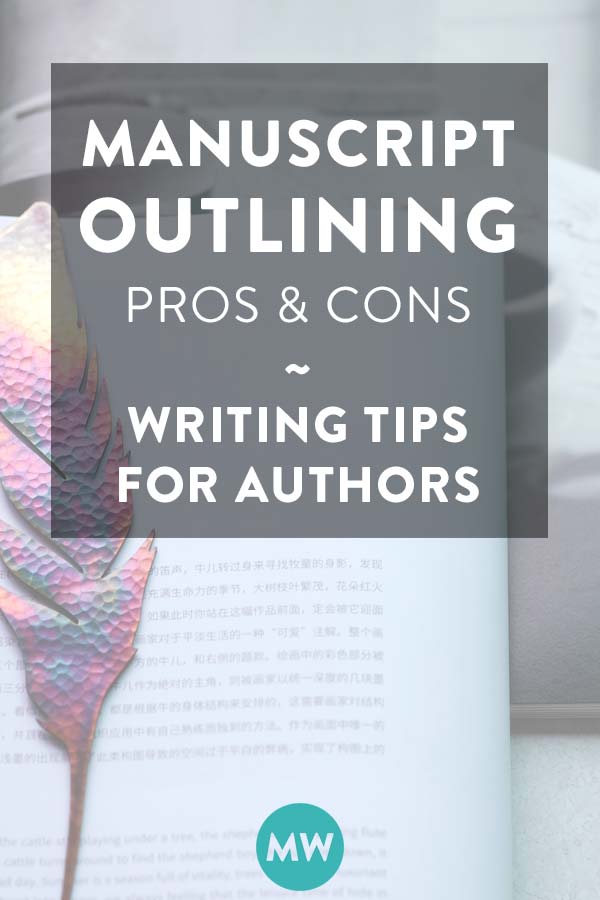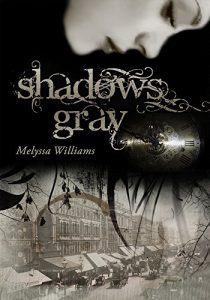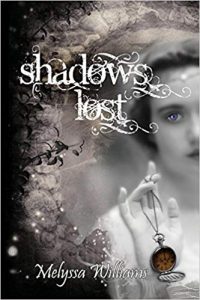To outline, or not to outline, that is the question.
There’s no black and white answer for every writer across the board, and you may have to experiment a bit to see what suits you and your personality. You may even find what works well for your first novel doesn’t come up to snuff on the next.
Please note that this post contains affiliate links, which means that if you purchase something you see on our site we may receive a commission at no cost to you. Read our full disclosure here.
Should I Outline My Manuscript?
Manuscript Outlining: Pros
Outlining can be close to a necessity when…
- You are writing a novel (or non-fiction) that is extremely complicated.
If your book involves a lot of characters and a lot of time arcs, then outlining will be your best friend and the only way to keep things straight.
Don’t fill up your mental real estate with facts and figures that could be looked up later with a minimum amount of work now. Albert Einstein said something to that effect.
- You are someone who can’t shop without a list, and/or adds every appointment to a book/calendar/notification system.
If this is you, then you are someone who love a good outline before you get started. You may feel completely lost and overwhelmed without one, like a boat without an anchor, a ship with a sea, a glass of wine without any cheese.
- You are a closet lover of office supplies
Let’s hear it for colorful Sharpies! Oh, how I heart them. If office supplies are your secret joy, then outlining can be not only practical but a fun way to let off some steam and show your creative side.
Post-it notes, journals, fancy pens, colored coded ink, thumbtacks and corkboards … it can get a little addicting.
- You like to see everything arranged in advance
You’re the type of personality who gets all of their ducks in a row first before starting a project, then getting your outline laid out is basically your set of ducks. Quack.
- You tend to let things wander
If you have the inclination to change things as you go – names of characters for instance (when Jack just has to become a Gus for some odd reason), places (suddenly your deli in Munich morphs into a pizzeria in New Jersey … it happens), or eras (this historical fairytale would be so fun set in a modern middle school, wouldn’t it?), then having your outline handy (and written in pencil), will save your bacon more than once.
Manuscript Outlining: Cons
You might find outlining to be a nightmare if…
- You are a writer first and foremost
Maybe all of the other areas besides the actual storytelling make you want to pull out your hair. An outline isn’t an absolute necessity for writing your book, and plenty of successful authors don’t use them. (Stephen King and Meg Cabot being two that come to mind.)
- Spontaneity is your middle name
Mine is Marie, but hey. If then you might find writing and using an outline to dampen your creative spirit to nothing less than a sad little spark. If outlining your novel makes you feel boxed in and tied down, outlining is hurting you more than it’s helping.
- It sucks up your time
If outlining is taking forever and it’s taking time and energy and heart away from the most important part of your book – actually writing the thing – then it’s time to put it away for now.
Perfectionists can focus too hard on the outline, get frustrated, turn to hard liquor and loose women, and goodness, we don’t want that. Well, some of you want that, but let’s focus on writing.
- There are too many options and resources
If you’re easily overwhelmed with all the “help” you find by researching something seemingly simple, such as How to Outline My Novel, then you’re going to get really bogged down and intimidated by just how many options and guidelines are out there.
You could easily spend a week learning different tricks, tips, templates, signing up for courses, watching tutorials, etc. In the meantime, your creative spark and your initial ideas may be gone, and suddenly you don’t even want to write a book anymore, because if preparing for it is so hard, confusing, and time consuming, then how can you ever finish an entire book?
Being distracted is already an author’s vice; no need to add fuel to the fire. Skip it.
Give it a Whirl
Maybe you fit neatly into one of those two categories: if so, you’re on your way already! Either to find your Sharpies, or to get tucked into your Chapter One, fingers flying and hearts racing.
But maybe you’re one of those mysterious types: an enigma wrapped in a mystery, shrouded in cryptic shadows, and served with a side of clandestine snack foods. If that’s the case, try outlining and see what happens! If nothing else, you’ll know soon enough if outlining your manuscript is the right choice for you.
Manuscript Outlining: Example
I’ve written novels both ways: outlining and winging it. Neither were more correct than the other, neither option made me feel less than, and I can’t say for sure that the next novel I write will have one.
Here’s an example of a timeline outline I used for my Young Adult trilogy. Dealing with time travel made having an outline imperative, because it was nearly impossible to keep the dates and eras straight. I knew one little mistake like Sonnet mentioning Portugal in 1850, but two books later putting her in Italy in the same year, would make one book reviewer annihilate me in a critique!
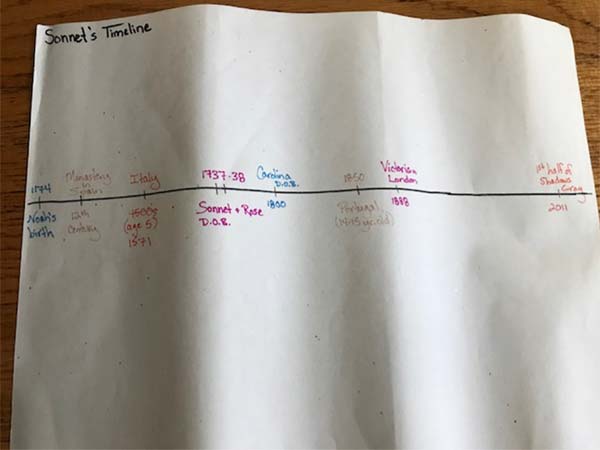
Sonnet’s wild child sister, Rose, got her own timeline for the sequel.
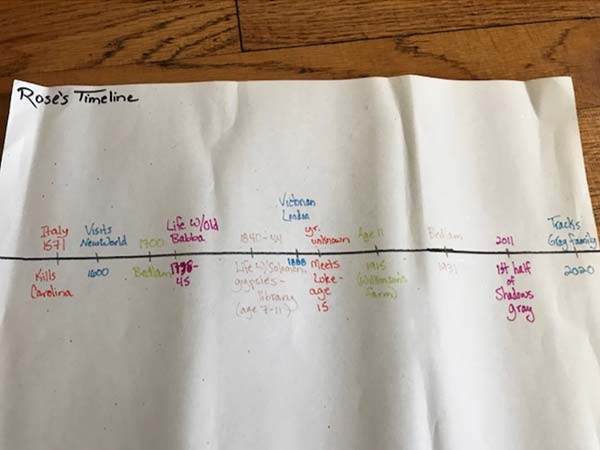
These were imperative for just dates and travels, but not really for plotting. For side characters and moving the plot along to its conclusion, I used this form of outlining:

This was how I could keep track of who was going where and I could instantly see if a character dropped off the map or if I left them behind accidentally (happens more than you’d think).
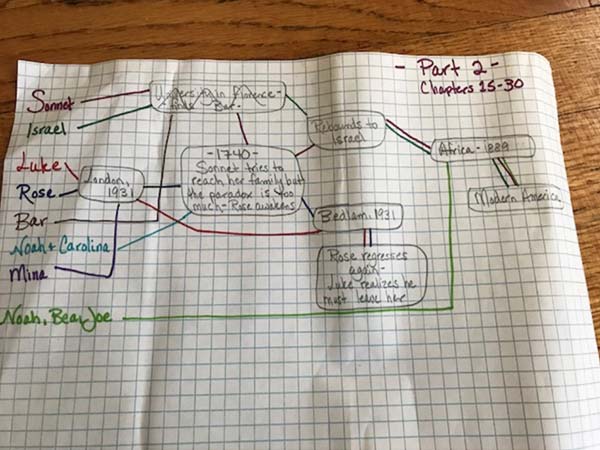
Each character gets a different color, then you can easily move them along to a different box.
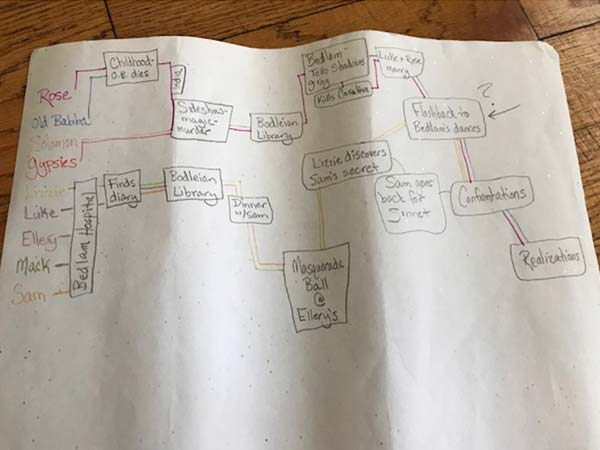
Excuse all the creases: they’ve been in storage. And also I evidently was channeling my inner archeologist and had them rolled up like ancient scrolls.
Choose Your Own Adventure
There are as many outlines for outlining as there are for anything else you can think of, so don’t get intimidated by types, examples, and the “right” way. The right way is what works for you!
J.K. Rowling shared her outline for Harry Potter and there were nearly as many words in it as there were in the actual novel. We all want to be J.K. but don’t get sucked into comparisons before you even get started.
Post-it notes on a poster board that easily be rearranged is a popular form of outlining, as is using a simple notebook with basic ideas, names, and ah-ha moments that come to you. Outlining one chapter at a time, then writing the chapter before moving onto the next outline can be useful too.
You’re working out different parts of your brain and it can keep you from getting bored and/or overwhelmed. If technology is your thang, invest in something like Scrivener.
Whether your outline is a handwritten and illustrated thing of beauty that you could hang in the Louvre, or a few scribbled lines on the back of your 711 receipt, a scotch-taped poster board to your bedroom wall, or a well-thought-out organized digital spreadsheet, remember the goal: your book. And how you get there doesn’t matter as much as arriving.
TL;DR
Weigh the pros and cons to decide if outlining is right for you.
Pros:
Outlining is helpful when:
- Your novel is complicated
- You want/need/love lists
- You have a passion for office supplies
- You like to see everything arranged in advance
- You tend to let your plot/characters/settings wander
Cons:
Outlining may not be right for you if:
- You are a writer first and foremost
- You love spontaneity
- Outlining sucks up your time
- You get overwhelmed with all the tips and “helpful” resources
PIN IT


